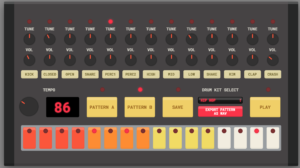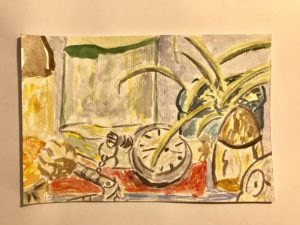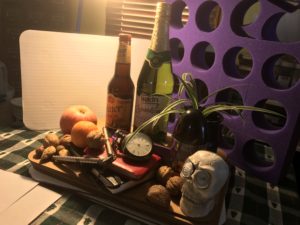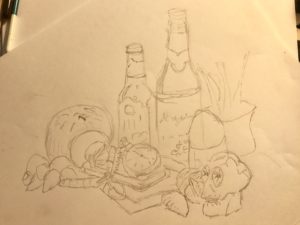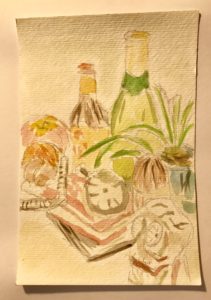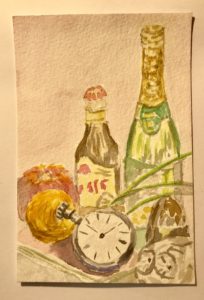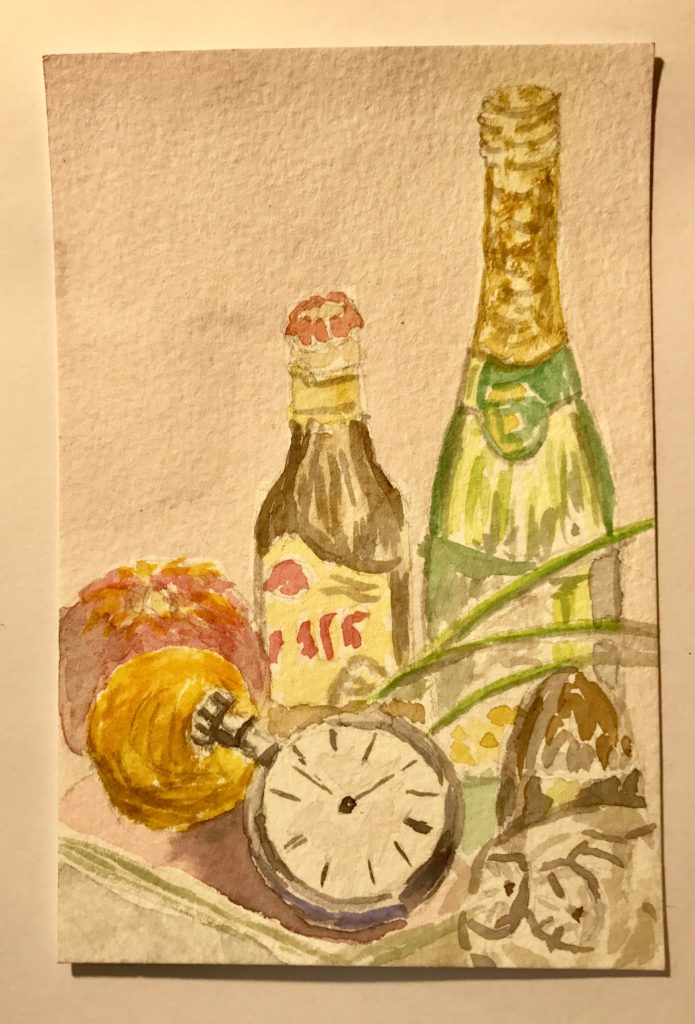I had a lot of fun playing around with this virtual drum machine. You might too.
All posts by Bill Genereux
Kids & PBL
Yesterday my daughter was involved in presenting at a teacher in-service about her work with the other students and her teacher on the topic of Project Based Learning.
I told her congratulations on making her first professional presentation. She said, “It wasn’t my first. I presented last year at the national FBLA conference in Baltimore.” Yes, I said, but that was a conference for kids. I’m not knocking that achievement, but this one is pretty special because it was meant for adult professionals. In a way, you could think of it as your first professional presentation since the intended audience was professional people.
So proud of this group being the only students to present for the #nck2019 inservice day! #CliftonClydePride
Great work @BarbGeorge1pic.twitter.com/gQEmFGagvQ— Art Baker (@baker_kansas) January 21, 2019
Practice What You Preach
Oops!
I justify using external services instead of courseware discussion boards so students can always refer back to previous discussions if they choose. However, I just deleted all of last year’s students from our private DigMe406 LinkedIn group. Doh! I shouldn’t have done that!
Thankfully, not much happened for that group on LinkedIn, more happened on Twitter, which can’t be deleted. I’m hopeful that this year more private discussion will happen on LinkedIn because we are starting our discussion there. Last year we started on Canvas discussions then I tried to get them to move to LinkedIn and it didn’t work well. People want to stick with what they started with.
Reflections on Teaching Online Classes in 2018
I taught several online classes during 2018. In the spring and summer terms, I taught a course on Social Media. In the fall, I taught an online course on Digital Literacy. In all of these courses, I emphasized the use of social media and digital tools. For each class, I required a video teleconference at the beginning of the semester with each individual student. That took many hours to visit with each student for 20-30 minutes, but I think it was a good investment to make that initial connection.
In the spring Social Media class, I initially requested that each student use our Beam+ telepresence robot to video conference with me, but that was not a popular option so I relented and let students use a video chat tool like Skype or Zoom. In one case, the student’s bandwidth was so poor, we just switched to a regular telephone conversation. In that case, the student was interested in using the robot, but simply couldn’t make it work.
Some students downright refused to use the robot, which I guess is somewhat understandable since it was uncharted territory and required installing special software to make it work. However, for those students who did try the robot in several cases, they told me that they appreciated how “real” the experience felt. They visited me during office hours and I was able to give them a brief tour around our building, even introducing them to some other students on campus.
Even though it was a big assignment, points-wise, a few students opted to not do the teleconference at all. Those are the students who consistently did the most poorly of all. I need to think about how to ensure that all students utilize the video conference and build connections with them. Being an online student is a lonely business! It is important to know that real people are out there and that they care.
For both spring and summer editions of the Social Media class, I followed a strategy that I frequently use. I shared my syllabus with the students and asked that they provide feedback and suggestions on some key points on how the course would operate related to grading and participation. I believe that sharing some of the decision making and control with students can assist with helping them to take some ownership of their learning and the class.
With online classes, it is difficult for me to know with any precision the needs of my students and what challenges they might be facing. So in asking them about things like what reasonable participation frequency throughout the week looks like, I’m getting some vital information about what they think is reasonable and we can have a discussion about it.
However, one of my students commented in his feedback on the course that it was inappropriate for the instructor to ask for student opinions about how the class and syllabus requirements should be structured. I think this says a great deal about what that student thinks education should be, what a class should look like and what the role of teacher and pupil should be. Over the years, I have learned that students naturally gravitate towards passivity and when the teacher asks them to think about such things it falls far outside of their comfort zone. They would rather have the teacher do all of the heavy lifting on such things whenever possible. But my belief is that when I share control over some aspects of a course, it is no longer a dictatorship but becomes a form of shared governance. It gives students some agency and responsibility for how the course turns out. That can be a little daunting for some students, I think. But in the end, I think it is a good thing.
The fall 2018 Digital Literacy class was overall a good one. We experimented with using several forms of online media for communication. However, at one point, there was a student who had some major concerns about one particular topic and its content; that of objectification and body image. My response to that situation took a great deal of energy and reflection. I consulted with several colleagues and my supervisor about possible approaches.
Ultimately, I followed the advice of Dale Carnegie and took the blame myself and apologized just to keep the peace, but to no avail. I requested on several occasions to have a real-time visit about the situation because I know through experience that text-based communications can make a sensitive situation even worse, but my student decided that I was in the wrong and that a cold shoulder was the best response for me.
The sad part of that whole business was that I essentially shared the same point of view as my student. I don’t think that people should be viewed or treated as objects. I introduced this topic for discussion because it is an important conversation to have with college students. I don’t think it is considered often enough.
However, it was my first attempt at dealing with the topic and it was admittedly not handled with as much finesse as it could have been. I apologized and tried to explain my thinking, but it ultimately was a missed learning opportunity for that student. However it did open up a good discussion in the class though, and I believe that most of the students ultimately understood the purpose of the assignment, even if they too were surprised by what they saw (some others said they were).
In these classes, I work hard to keep things interesting and relevant. I challenge them with new ideas they might not have considered before. I emphasize critical thinking about the various forms of media they are using on a daily basis. We are using tools and technology in ways that they have never tried before. Learning is hard and it is uncomfortable to be challenged. But I think we are doing some good work in these online classes even though we will never meet face to face.
Pi computers in Hardware and Networking Class
for the fall 2018 semester in CMST 250 – Hardware & Networking class, I purchased six Raspberry Pi computers for the purpose of introducing this platform with its Linux system in the labs. The students were very engaged with this technology. They never imagined that such a powerful system could exist in a computer the size of a deck of cards for less than $50. Of course, they use smartphones that are compact in size and some are more powerful, but they don’t really think of phones as computers. The Raspberry Pi has all of the peripherals of a home PC like a mouse, keyboard, and monitor and it looks and feels like (it actually is) a real computer.
We learned how simple it is to download free software and get a system up and running in a short time. We also saw how easy it is to customize and add new programs through the CLI (command line interface). For many students, CMST 250 is the first time they have had to use a CLI. They find it more difficult than a windows based system, and it can be a hard sell with the Cisco systems we have always used. By using the Pi system, they really see the simplicity. By typing in a few commands, they can set up a working web server right on the Pi. Doing the same thing as we always have done on a Windows system requires going to the right website, downloading the right web server software, installing and configuring it. It is a much more complicated process to do the same tasks on Windows than on the Pi’s Linux system. I plan to continue using the Pi computers and develop new lab activities with them.
Some Reflections on the Humanities Class
It took me several years and a road trip to Michigan for me to become acquainted with Kathy Brockway, a colleague at K-State. We became friends at the Wakonse conference on college teaching in 2008. I have long known she is an outstanding teacher and an inspiration to others, but the fall 2018 semester was the first time I was able to see her in action in the classroom first hand and close up. She is so dynamic!
In a somewhat last-minute decision, I was assigned to teach a new course called Mastering Academic Conversations, also known in some circles as a freshman experience course. Although I had previously taught a similar survey course in arts and humanities, this particular course was conceived and developed by others. My humanities course was not exclusively offered for first year students, but that was the purpose of this new course.
Originally I was to team teach the course with Prof. Brockway, but that quickly changed and I was assigned two of my own sections to teach in the course. Fortunately, one of the sections overlapped with hers, and the classroom she was assigned was large enough, so early in the semester we made the decision to join our sections together for certain sessions. This arrangement worked so well that for most of the semester, we taught together as a team with our two sections combined as one class.
Having a larger group of about 30 students really changed the dynamic of the class from two smaller groups. We had better discussions, and working together with a colleague energized us. Depending on the topic and the circumstances, either of us could take the lead on a given day. Honestly, I often leaned heavily on Kathy for support as she had been through the class previously and it was my first time. However, there were days where the topic was of greater interest to me and I took the lead on the activities and discussions.
I once remarked that I felt like the two of us made a great instructional team. Our personalities complemented each other as she is more extroverted and I’m more introverted. Although Kathy often led, I felt like I had her back and brought much to the table as well to keep things moving forward. Johnny Carson and Ed McMahon come to mind as an analogy.
However, the larger group also presented new challenges. Both of us felt that we had never had a more distracted, self-absorbed group of students than some of those in this bunch. Not everyone was like this, but some were hard to miss. There always seemed to be a din of motion and murmuring, sometimes full voice conversations competing with whomever happened to have the floor, teacher or classmate alike. Some students simply could not sit still or be quiet, which was frustrating at the time, but upon reflection I realized that it showed engagement. Often the side conversations began with some compelling idea being considered in the class. Instead of being irritated by it, I think in the future I need to figure out a way to plan for it and harness it.
What was so important about moving forward anyhow? Why not recognize which ideas most resonate with the students and purposefully build more time in for small group discussions, then later bring it back to the larger group?
But there is definitely a maturity issue in play here and an issue of executive control. Seeing other points of view, including those of teachers and classmates, and exercising empathy are something that need our ongoing attention and practice.
Some of our topics and discussions caused some discomfort. I think that is a good thing as we get students to examine their own beliefs and point of view on things. We had things get to the point where a student just got up and walked out of class, we had more than one heated discussion in which not only the professors, but the more experienced non-traditional aged students exercised leadership in guiding the conversation. I think the most important aspect of this was that we modeled respecting others, even if we disagree.
I think because there were so many cooks with this pot (we had five faculty members teaching multiple sections of this class) there were at times competing philosophies with regard to what and how the course should be taught. At times I think we just had to respectfully agree to disagree.
One of the things I feel we can improve upon is how we begin and end the course. We started with five weeks of administrative tasks and academic theory and we ended with a music concert. In my opinion, we should begin with the concert and conclude with a review of how the pieces fit together in a larger picture.
To me, the worst way one can begin a course is with a discussion of the syllabus’ contents. I want to begin my semester with a bang. As some of my colleagues refer to it, I want to “Rock the First Day.” I always save the syllabus for the second class session. Sometimes I wonder if I shouldn’t “flip” that part of the course and give it as a take-home assignment, with subsequent discussion and assessment that doesn’t even take an entire class session.
But this course began with discussions of syllabus and course policies, the honor system, and other administrative and academic details. And it wasn’t one session either. It took five weeks before we delved into any specific humanities topic. Don’t get me wrong, it is important to discuss information literacy and critical thinking, but we can do these things in the context of examining the various humanities topics like art, literature and the media.
Our librarian, Katherine Jones, is a great and underutilized resource. We had her come in for a joint seminar session to talk about information literacy and how to use the library resources for research. I would like to see her become more involved throughout the semester in the freshman course. She is excellent at what she does, and I think she relates well with students.
On a related note, I felt like our current student demographics are less than an ideal situation. I really feel for the young women attending our classes when they are outnumbered nine to one. Really? In a world where women as a rule are now attending college more often than men, why in the world are there so few women in our classes? I was hopeful about this situation a few years ago when I actually had a computer class with nine women and three men. I thought we had started a new chapter, but it was actually just an outlier year. WE NEED TO FIX THIS ISSUE!
My favorite parts of the semester were all about the arts and humanities. The field trip to the art center to do the downtown sculpture tour, the trip to the Smoky Hill Museum, and the play at the Salina Community Theatre. I was saddened by how many people missed or left early from these events. I’d like to think about some ways to make it difficult to miss or leave early.
We did some additional activities that were engaging. My favorites include the pencil drawing activity we did with drawing each others’ shoes. It was interesting to see how students responded to drawing another person’s shoe. I would like to expand this next time with a lesson from Betty Edwards Drawing on the Right Side of the Brain on seeing what is actually there instead of what you think you see. Another favorite was examining the Thanksgiving holiday by reading accounts of the Puritan holiday from various sources, including those of modern Native Americans. The financial literacy portion put on by Kathy was also popular and led to some thoughtful discussions.
Overall, it was a great semester and a great collaboration. I feel like together, Kathy Brockway and I did a great job. I realize the humanities are more my thing than Kathy’s thing, but she brings so much fun and excitement to the course I hate to think of what it would be like without her. If we get the chance to do it again using this format, I know we’ll make it even better next time around.
Take Five
I love this song, but never knew its name or what it was called.
Today I learned about 5/4 time and Dave Brubeck by searching for the TV theme from Mission Impossible for today’s Daily Create.
Raindrops Keep Falling on my Head
Today’s Daily Create was to make a mashup. I decided to do one of music and an image. Then I decided to record my own music and use my own photograph. My New Year’s resolution was to make more things and write more on my blog, so this post is a daily create activity that sort of got out of hand. Daily Creates are typically done in 10-15 minutes or so, but this one took considerably more than that. But that’s ok. That’s the whole idea of doing daily creative activities. Sometimes it leads to something more substantial.
I used an app on my iPad called Voice Record Pro by Dayana Networks. I love this app. It is the Swiss Army Knife of audio recording apps. I sometimes use it in my Hardware and Networking class to demonstrate the concept of a server. Voice Record Pro is so versatile, it includes a web server feature that turns your iPad into a web server so you can easily download your recordings. There are about a dozen other ways to get your files as well. For example, you can upload directly to YouTube in video form, you can send it to your other Apple devices via AirDrop (my favorite way). If you are a user of Apple devices and don’t use AirDrop you are missing out. It is the simplest of ways to transfer files from one device to another but only works on Apple products.
I recorded the ukelele part, then I recorded myself singing as well and mixed these files together in Adobe Audition. I think when I get more confidence, I’ll play and sing at the same time. Finally, I brought the audio into Adobe Premiere and added some pictures and simple animations to be rendered as a video that I then uploaded to YouTube.
Cezanne and the rotten fruit
My art teacher once told me that Cezanne painted the same scene so long his apples rotted but he kept painting anyway. Like a normal student, I didn’t question it. Until today! This piece says he liked fruit because people move. I learned something! #tdc2557
https://www.artsy.net/article/artsy-editorial-portraits-cezanne-treated-sitters-fruit
My daughter and I painted a still life together over the break. Undoubtedly we were in keeping with Cezanne’s still life tradition although I didn’t think about it at the time.
I found another interesting article called Everything You Need to Know About Cezanne’s Fruit. http://www.dailyartmagazine.com/all-we-know-about-cezannes-fruits/
New Year’s Still Life 2019
My daughter has been asking me to paint with her. I finally made some time for painting over the New Year’s holiday. We set up a still life of objects we found from around the house. We put an ordinary desk lamp above it for lighting. Here is a photo of the items we found.
My daughter is working with acrylic paints and I have been using watercolors.
First, I suggested we make sketches as a warmup activity. Here is my sketch.
Then I painted a first draft painting. Here is my first draft.
I did two more iterations of the same still life arrangement. Each time I zoomed in the focus of my attention a little more. Here is my second painting
‘See how my strokes are bolder and more confident this time? I left out some of the details.
Finally, here is my third painting. I was interrupted in the middle of making this one. It is a lot more free than the first two.
Today’s Daily Create calls for making a composition using the Rule of Thirds. I typically have this rule in the back of my mind whenever I am making drawings or photographs although it varies on how closely I adhere to it.
Out of the three paintings, I think still life number two most closely follows the rule of thirds.
